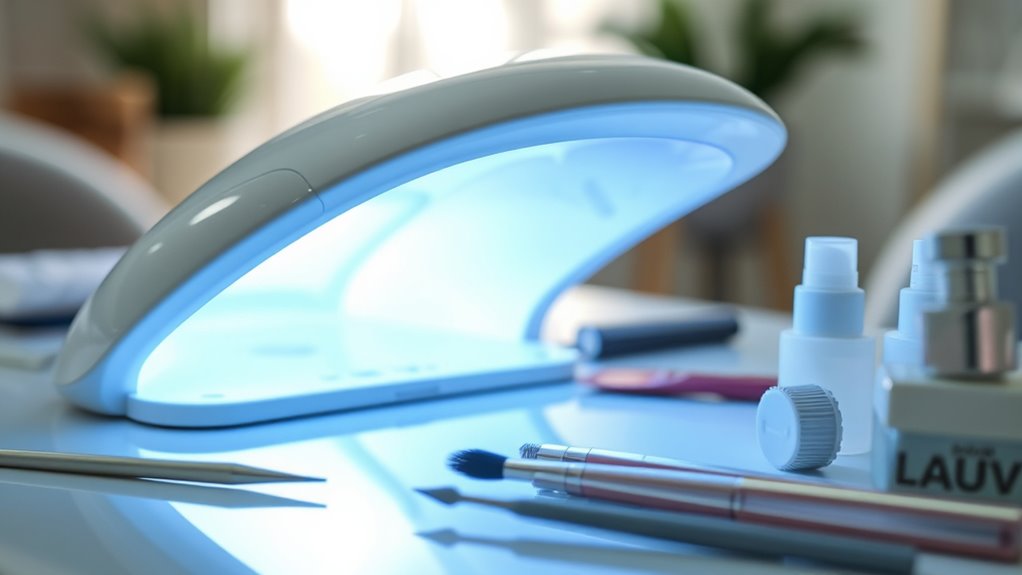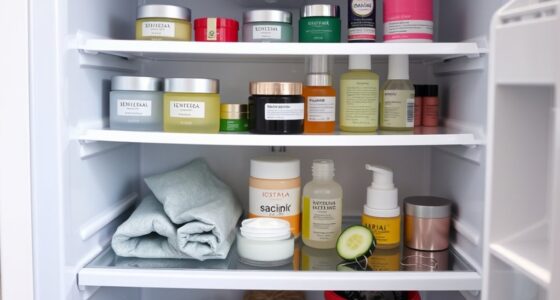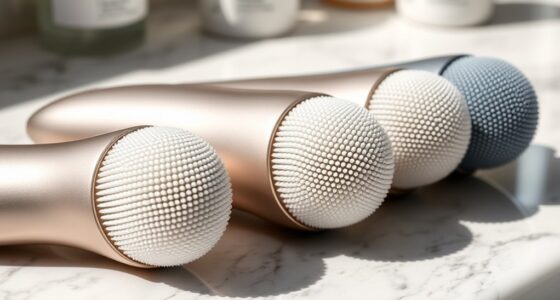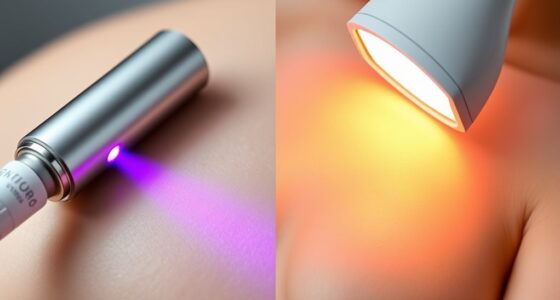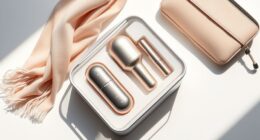When using UV nail lamps, always wear gloves with only your nails exposed to protect your skin from UV damage. Follow the recommended curing times—usually 30-60 seconds per layer—and use a timer to avoid under or over-curing. After curing, avoid water and harsh chemicals for an hour and moisturize your cuticles regularly. Keep your lamp clean and replace bulbs as needed for safety and better results. Discover more tips to keep your nails healthy and safe.
Key Takeaways
- Always wear protective gloves exposing only nails to reduce UV skin exposure and minimize health risks.
- Follow manufacturer-recommended curing times, typically 30-60 seconds per layer, using a timer for accuracy.
- Ensure the UV lamp is clean, well-maintained, and bulbs are replaced regularly to ensure effective and safe curing.
- Avoid staring directly at the UV light and position hands comfortably to prevent eye strain and discomfort.
- After curing, wait at least an hour before water or harsh chemicals contact nails, and regularly moisturize cuticles for healthy skin.
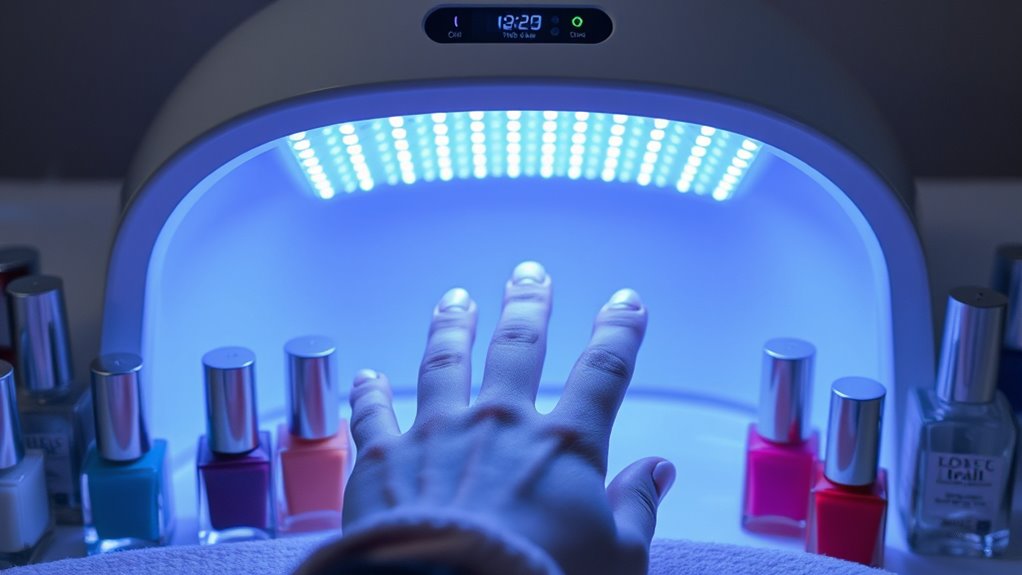
UV nail lamps are essential tools for achieving professional-looking gel manicures at home or in salons. They help you cure gel polish quickly and efficiently, guaranteeing your manicure lasts longer and looks flawless. When using a UV lamp, it’s important to understand how to operate it safely, manage curing times properly, and care for your skin afterward to prevent damage. As you work with these lamps, always follow the manufacturer’s instructions and pay attention to recommended curing durations to avoid overexposure.
Safety should be your top priority when using UV nail lamps. Since UV radiation can damage your skin over time, wearing protective gloves that expose only your nails is a good idea. These gloves block most of the UV rays, considerably reducing your risk of skin aging or potential carcinogenic effects. If you prefer not to wear gloves, make sure to limit your exposure time and avoid using the lamp more frequently than necessary. Always position your hands comfortably, and avoid staring directly at the UV light during curing. Keep the lamp clean and in good working condition, replacing bulbs as needed to guarantee even curing and maximum safety.
Timing is vital when working with UV nail lamps. Most gel polishes require a curing time of 30 to 60 seconds per layer, but this can vary depending on the lamp’s wattage and the specific gel brand. Using too little time may result in a tacky or uneven finish, while over-curing can cause the gel to become brittle or discolored. To get it right, follow the instructions provided with your gel polish and your lamp. Use a timer to track each curing session precisely, and double-check your nails under a light to ensure they’re fully cured before applying additional layers or finishing with a top coat.
Aftercare is just as important as proper usage. Once your nails are cured, avoid exposing them to water or harsh chemicals for at least an hour to let the gel fully set. Moisturize your cuticles regularly with cuticle oil to keep your skin healthy and prevent dryness. If you notice any signs of irritation or discomfort from UV exposure, give your skin a break and consider switching to LED lamps, which often emit less UV radiation. Additionally, always clean your UV lamp after each use to prevent dust, gel residue, or bacteria from building up, which could affect future manicures. Taking these steps not only prolongs the life of your gel manicure but also helps keep your skin safe and healthy over time.
Frequently Asked Questions
Are UV Nail Lamps Safe for Pregnant Women?
UV nail lamps may not be entirely safe for pregnant women, as exposure to UV rays could pose potential risks. While there’s no definitive evidence of harm, it’s best to limit exposure during pregnancy. You can consider alternatives like LED lamps, which emit fewer UV rays, or opt for gel polishes that don’t require UV curing. Always consult your healthcare provider to ensure safety for you and your baby.
How Often Should I Replace My UV Nail Lamp Bulbs?
You should replace your UV nail lamp bulbs every 12 to 18 months to guarantee peak performance and safety. Over time, the bulbs lose their effectiveness, which can lead to uneven curing and longer drying times. Keep an eye out for signs like dimming or less efficient curing. Regularly checking your bulbs and replacing them as recommended helps maintain safe, effective use and prolongs your lamp’s lifespan.
Can UV Nail Lamps Cause Skin Aging?
Think of UV nail lamps as the sorcerer’s wand—powerful but potentially risky. Yes, prolonged exposure can accelerate skin aging, much like the sun’s rays do. To protect yourself, limit your sessions, use broad-spectrum sunscreen, and wear UV-protective gloves for your fingertips. These simple steps help you enjoy beautiful nails without the unwanted signs of aging, keeping your skin youthful and healthy.
Are LED Nail Lamps Safer Than UV Lamps?
Yes, LED nail lamps are generally safer than UV lamps because they emit less UV radiation, reducing your risk of skin damage and aging. LED lights cure nails faster and tend to cause less heat and discomfort. However, it’s still a good idea to wear UV-protective gloves or apply sunscreen on your hands for added protection. Always follow safety guidelines to keep your nails healthy and safe.
What Are the Signs of Overexposure to UV Nail Lamps?
In the dawn of the digital age, you should watch for redness, dryness, or peeling skin around your nails. If you notice a burning sensation or persistent sensitivity after using the lamp, it’s a sign of overexposure. You might also experience swelling or blistering. These symptoms indicate your skin is reacting negatively, so it’s best to limit exposure, apply moisturizer, and consult a professional if issues persist.
Conclusion
Remember, using your UV nail lamp safely is like tending a delicate garden—you need the right timing and aftercare to keep everything thriving. I once rushed a session and ended up with a dull, peeling manicure, reminding me that patience and proper care make all the difference. By following safety tips and giving your nails a break, you’ll enjoy beautiful, healthy nails that blossom just like a well-tended garden—bright, strong, and lasting.
